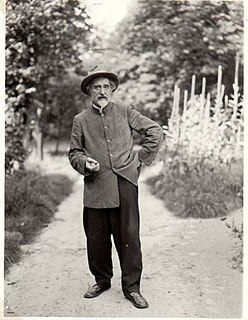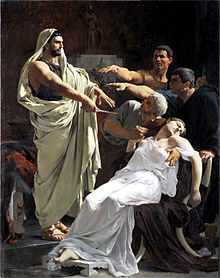
Art Nouveau is an international style of art, architecture, and applied art, especially the decorative arts, known in different languages by different names: Jugendstil in German, Stile Liberty in Italian, Modernisme català in Catalan, etc. In English it is also known as the Modern Style. The style was most popular between 1890 and 1910 during the Belle Époque period that ended with the start of World War I in 1914. It was a reaction against the academic art, eclecticism and historicism of 19th century architecture and decoration. It was often inspired by natural forms such as the sinuous curves of plants and flowers. Other characteristics of Art Nouveau were a sense of dynamism and movement, often given by asymmetry or whiplash lines, and the use of modern materials, particularly iron, glass, ceramics and later concrete, to create unusual forms and larger open spaces.

The Basilica of the Sacred Heart of Paris, commonly known as Sacré-Cœur Basilica and often simply Sacré-Cœur, is a Roman Catholic church and minor basilica in Paris, France, dedicated to the Sacred Heart of Jesus.
This is a timeline of architecture, indexing the individual year in architecture pages. Notable events in architecture and related disciplines including structural engineering, landscape architecture, and city planning. One significant architectural achievement is listed for each year.

Luc-Olivier Merson was a French academic painter and illustrator also known for his postage stamp and currency designs.

The Sacred Heart Cathedral, properly the Cathedral of the Sacred Heart of Jesus and also known as the Stone House by locals, is a Gothic Revival Roman Catholic cathedral in Guangzhou, China. It is the seat of the Archbishop of Guangzhou. The cathedral is located at 56 Yide Road, on the north bank of the Pearl River at the heart of the old town. It is one of the few cathedrals in the world to be entirely built of granite, including all the walls, pillars, and the twin towers.

Baldassare Tommaso Peruzzi was an Italian architect and painter, born in a small town near Siena and died in Rome. He worked for many years with Bramante, Raphael, and later Sangallo during the erection of the new St. Peter's. He returned to his native Siena after the Sack of Rome (1527) where he was employed as architect to the Republic. For the Sienese he built new fortifications for the city and designed a remarkable dam on the Bruna River near Giuncarico. He seems to have moved back to Rome permanently by 1535. He died there the following year and was buried in the Rotunda of the Pantheon, near Raphael.

The Basilica of the Sacred Heart in Notre Dame, Indiana, USA, is a Roman Catholic church on the campus of the University of Notre Dame, also serving as the mother church of the Congregation of Holy Cross (C.S.C.) in the United States. The neo-gothic church has 44 large stained glass windows and murals completed over a 17-year period by the Vatican painter Luigi Gregori. The basilica bell tower is 230 feet (70 m) high, making it the tallest University chapel in America. It is a contributing building in Notre Dame's historic district listed on the National Register of Historic Places. The Basilica is a major tourist attraction in Northern Indiana, and is visited annually by more than 50,000 tourists.

Franz Mayer of Munich is a German stained glass design and manufacturing company, based in Munich, Germany, that has been active throughout most of the world for over 170 years. The firm was very popular during the late nineteenth and early twentieth century, and was the principal provider of stained glass to the large Roman Catholic churches that were constructed throughout the world during that period. Franz Mayer of Munich were stained glass artists to the Holy See and consequently were popular with Roman Catholic clients. The family business is nowadays managed in the fifth generation and works in conjunction with renowned artists around the world.

Jean René Bazaine was a French painter, designer of stained glass windows and writer. He was the great great grandson of the English Court portraitist Sir George Hayter.

The Master of Saint Francis was an anonymous Italian painter, perhaps of Pisan origin though probably trained in Umbria, working between 1250–1280. His work embodies an important aspect of the Italo-Byzantine style resulting from contact between Italian and Byzantine art of this period.

Minor Basilica of the Immaculate Heart of Mary, is a titular church in Piazza Euclide, Rome. It was built by the architect Armando Brasini (1879–1965). Its construction began in 1923 with the design of a Greek cross inscribed in a circle with an articulated facade, and completed before 1936, the year in which it was made a parish church and granted to the Congregation of Missionary Sons of the Sacred Immaculate Heart of Mary, usually known as the Claretian Missionaries. A grand dome was planned, but never realized; a smaller drum was completed in 1951.

The Basilica of Saint Clotilde is a basilica church in Paris, located on the Rue Las Cases, in the 7th arrondissement. It is best known for its twin spires.

Marie-Alain Couturier, O.P., was a French Dominican friar and Catholic priest, who gained fame as a designer of stained glass windows. He was noted for his modern inspiration in the field of Sacred art.

Constant Montald was a Belgian painter, muralist, sculptor, and teacher.

The Temple Expiatori del Sagrat Cor is a Roman Catholic church and minor basilica located on the summit of Mount Tibidabo in Barcelona, Catalonia, Spain. The building is the work of the Spanish architect Enric Sagnier and was completed by his son Josep Maria Sagnier i Vidal. The construction of the church, dedicated to the Sacred Heart of Jesus, lasted from 1902 to 1961.

Ernest Jean Gaudin was a French painter, glass and mosaic artist.

Nicolas-Auguste Hesse was a French painter and artist. He produced historical, mythological, religious and allegorical works along with portraits, wall paintings and designs for stained glass windows.

Charles Lebayle was a French painter and designer, who is mostly known for his collaborations with stained glass makers.

Charles Jean Baptiste Claude Lorin is a French glass painter and manufacturer, born on 16 October 1866 in Chartres, capital of the Eure-et-Loir department, and died in the same city on 23 April 1940.
Hubert Vincent McGoldrick was a Dublin born stained glass artist, one a small number of Irish artists which included Michael Healy, Wilhelmina Geddes, Evie Hone, and Harry Clarke, who worked in this medium and achieved international recognition for their work in the first half of the 20th century. His career at An Túr Gloine spanned from 1920 until 1943; thereafter he produced very few works in the medium. Along with Ethel Rhind and Catherine O'Brien he was one of the artists at the studio who worked in opus-sectile mosaic, a side-line of the studio. Hubert McGoldrick was also an occasional illustrator and his most recognised illustration is the Magnificat Anima Mea Dominum created for the Legion of Mary.




















